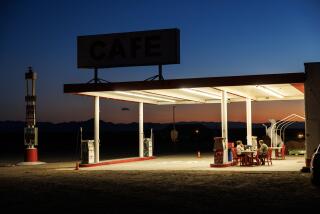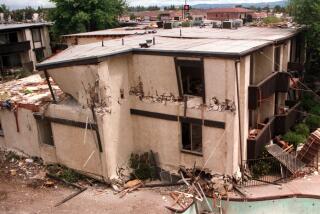They Still Get Kicks on Route 66, U.S. Memory Lane : Tourists Discover, Old-Timers Recall Old Highway’s Heyday
- Share via
HYDRO, Okla. — The people at Lucille’s Service Station have pumped gas on Route 66 long enough to be of interest to history buffs.
Eula Mae Brown, 67, remembers when it was something to have a traveler perched on the Nehi icebox at her father’s filling station turn out to be someone from the East Coast.
“I always found it just exciting!” she said. “Some of the people who talked a different dialect would amuse me so.”
Nowadays, those who pull up to the pumps under the station’s old-fashioned clapboard overhang have British accents, Australian accents.
They ask Lucille Hamons to autograph her picture in a glossy book about Route 66. She has run the station since her husband took it over in 1941, 14 years after Brown’s father built it.
Hamons sells sandwiches and soft drinks from her gas station. Since 1966, she also has sold what she calls the coldest beer in Oklahoma.
“You know who will be coming here next, don’t you? It’ll be the Japanese,” she said, anticipating the next wave of tourists on the highway from Chicago to the West Coast.
Tulsa writer Michael Wallis said he has seen Japanese tourists and filmmakers at barbecue joints and cafes along Route 66 this year. Four independent studios are filming documentaries about the highway, he said.
St. Martin’s Press is due to publish Wallis’ book about the road this spring, and he plans to tool down 66 in a 1964 Corvette to promote it.
Route 66 crosses eight states and three time zones, starting out at the shores of Lake Michigan in Illinois. It makes its winding, wooded way south from the lake, and from Oklahoma City on, makes a pretty straight shot through the Plains, over the Rocky Mountains, across the desert and coastal ranges and on to the beach at Santa Monica.
It opens to four lanes in spots, but is mainly a two-lane highway with curbs and curves that used to send Packards and Plymouths spinning off into the trees.
Legislation that would make all 2,400 miles of 66 a national monument is pending in Congress. This winter, Kansas became the eighth and final state to establish a Route 66 association, Wallis said.
Oklahoma tourism is catching on. Promoters plan a Route 66 car rally and a “Mr. and Mrs. Route 66” contest this summer. Businesses are capitalizing on the location to sell everything from art to antiques.
Oklahoma could gain from the fact that its stretch of Route 66 retains more of its old character than those through some other states, Wallis said.
Oklahoma also happens to be the only state that earned a qualitative statement in a song that names cities along Route 66 (“ . . . you go through Saint Louey, Joplin, Missouri, And Oklahoma City is mighty pretty. . . . “).
Bobby Troup thought up the lyrics while driving out to California after he got out of the service. Pop singer Michael Martin Murphy’s version is the 25th recording of the song about getting your kicks on Route 66, Wallis said.
And then there was the 1960-64 television series starring Martin Milner and George Maharis who traveled Route 66 in their Corvette. The program’s theme song, written by Nelson Riddle, made the pop charts in 1962. Glenn Corbett replaced Maharis in 1964.
“But this is a case where nostalgia has really symbolized the best of something,” Wallis said. “It’s still a corridor of America that’s not generic.
“It’s an America that’s before fax machines and fern bars, before the malling of America,” he said. “I remember when it was an adventure, starting when Dad used to back the Plymouth down the highway.”
There were 40 years when “I can’t even think how you could have left New York City and go to the coastline without coming by our little store,” Brown said.
She saw the first motorists who were brave enough to try the notion of a road that let one drive from Lake Michigan to the Pacific Ocean without once having to stop to ask directions.
Hamons saw the exodus of the Okies (distinguishable from the Arkies, she said, by the single, rather than the double, layers of mattresses atop their cars). She saw the post-World War II migration of which Troup was a part; she sold cold Nehis and rented cabins to the tourists who followed.
Hamons started selling beer to survive after road crews plowed up a temporary ramp leading off the new Interstate 40, parallel to 66, she said.
She claims the title of longest continually operating merchant on Route 66 in Oklahoma. No newfangled buildings have spoiled her stretch of 66 because there was little development money after the interstate came.
Today, Hamons sells Route 66 T-shirts, coffee mugs and message magnets as well as beer. She is thinking of reopening one of the tourist cabins out back to accommodate an expected increase in trade this summer.
“It’s what you’ve seen, and who you’ve come to know,” she said. “To me, that’s 66. It’s not so much a money-making deal. It’s just memories.”
More to Read
Sign up for The Wild
We’ll help you find the best places to hike, bike and run, as well as the perfect silent spots for meditation and yoga.
You may occasionally receive promotional content from the Los Angeles Times.






